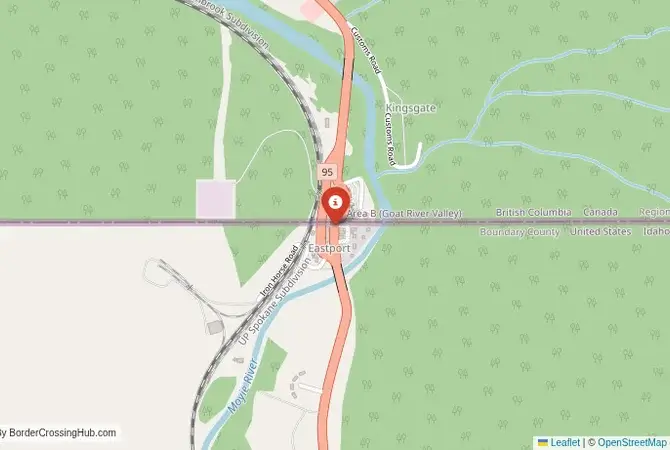
Approximate Border Location
Border Countries
- 🇺🇸United States
- 🇨🇦Canada
Border Cities
- 🇺🇸Eastport, Idaho
- 🇨🇦Kingsgate, British Columbia
Wait Times
15-30 min for pedestrians/vehicles
Operating Hours
Open 8:00 AM – 6:00 PM
Crossing Types
Pedestrians, vehicles
Border Type
Land crossing via road
Peak Times
Mornings (7-10 AM)
Daily Crossings
~600 travelers/vehicles
Currency Exchange
Limited near Eastport (USD, CAD)
Safety Information
Remote, beware weather
Languages Spoken
English
Accessibility Features
Ramps
About Eastport, Idaho & Kingsgate, British Columbia
A Busy Trade Hub
The Eastport-Kingsgate border crossing connects Idaho’s northern panhandle with British Columbia’s interior, serving as a vital yet understated link between the U.S. and Canada. Unlike bustling crossings like Peace Arch, this port maintains a low-key atmosphere, primarily handling commercial trucks loaded with timber, agricultural products, and other freight. It’s a key artery for the regional economy, supporting livelihoods in logging, farming, and small businesses on both sides. Travelers—often locals or adventurers exploring the Rocky Mountains—appreciate its calm pace. Open 24/7, it’s a dependable option for late-night haulers or early risers, with delays rarely stretching beyond a few minutes.
Historical Roots
Established in the early 1900s, this crossing emerged to serve the booming logging and mining industries that defined the region. Initially, it was little more than a rugged dirt trail, manned by customs officers armed with pencils and logbooks. Over decades, it transformed into a modern facility, though it retains a rustic, frontier-like charm. In its early days, the Kingsgate customs post was a modest wooden shack—far cry from today’s infrastructure. During the 1920s, Prohibition sparked a surge in illicit traffic, with bootleggers smuggling whiskey across the border, often concealed in timber loads. These tales of ingenuity linger in local storytelling, adding a layer of intrigue to this otherwise tranquil crossing.
Before Crossing
Crossing borders gets messy sometimes, think political flare-ups or gates shutting fast. Good travel insurance is a must for handling doctor visits, trip disruptions, or security scares. Don’t get caught unprepared. To find a policy that’s got your back, check out reliable plans today for peace of mind.
Crossing Process and Wait Times
Crossing here is straightforward and swift. U.S. and Canadian border agents process travelers efficiently, with wait times typically under 15–20 minutes, even during peak periods like early mornings or late afternoons. Its round-the-clock operation suits truckers and night travelers, and its compact layout avoids the confusion of larger ports. Passports or Nexus cards are a must—have them ready. For real-time updates, check the CBP or CBSA websites. Winter travelers should note that snow may slow progress, though plows keep the roads clear. It’s a hassle-free experience compared to more congested crossings.
Scam Warnings
Scams are uncommon here, but vigilance pays off. Occasionally, dubious “guides” might offer to expedite your crossing for a fee—steer clear. Official staff never solicit extra payments beyond duties or taxes. Be wary of online travel deals promising special perks at Eastport-Kingsgate; they’re often scams. Stick to official channels and marked lanes, and you’ll avoid trouble. The crossing’s quiet nature keeps shady activity low, but it’s wise to stay cautious.
Transportation Options
Driving is the way to go—Highway 95 (U.S.) and BC Highway 3 (Canada) lead directly to the border. Public transit doesn’t serve this remote spot, so a car is essential. Pedestrians can cross, but it’s uncommon and impractical without a pickup plan. Car rentals are available in nearby Bonners Ferry, Idaho, or Creston, BC. Cyclists will find the route scenic but challenging, with steep hills and narrow shoulders—pack stamina and caution. Gas up in Bonners Ferry or Yahk, both about 10 minutes away, as there’s no fuel at the crossing itself.
Road Conditions and Scenery
The roads are solid year-round, though winter demands snow tires or chains from November to March. The drive offers stunning views—pine forests, the Purcell Mountains, and occasional wildlife like deer or moose on the Canadian side. Summer brings wildflowers, while fall paints the larches gold, making it a photographer’s paradise. Logging trucks rumble through regularly, so stay alert, especially on weekdays. It’s a peaceful, nature-rich journey that feels like a reward in itself.
Nearby Attractions
Within reach, there’s plenty to explore. South of the border, the Kootenai National Wildlife Refuge (20 minutes away) offers hiking and birdwatching. Northward, Creston, BC (30 minutes), boasts orchards, wineries, and a museum delving into settler and Indigenous history. For a quirky detour, Yahk’s Soap and Candle Company sells handmade treasures. Hungry? Bonners Ferry’s Under the Sun café serves hearty meals and local beer, perfect for a post-crossing stop.
Cultural and Economic Significance
This crossing binds two rural communities with shared values—hard work, nature, and a love of the outdoors. It fuels Idaho’s logging and farming economies while opening BC’s interior to trade and tourism. Locals exude a friendly, cross-border spirit, evident in casual chats at diners or gas stations. Events like the Creston Valley Bird Festival unite both sides, celebrating the region’s wildlife and fostering cultural exchange.
Travel Tips
Bring snacks—there’s no food at the crossing itself. Cell service dips near the border, so preload maps. Winter travelers should monitor weather and road conditions; snowstorms can snarl plans. Declare all goods—agents are laid-back but firm on rules. For a smooth trip, cross mid-morning or late evening when traffic thins. Photographers, aim for sunrise or sunset for breathtaking mountain shots.
Extra Tips
Chat with locals—they’ve got stories, like the time a bear strolled through the checkpoint in the ‘90s, that’ll make your visit memorable. Enjoy the ride—this border’s a hidden gem worth savoring.
No reviews yet.
